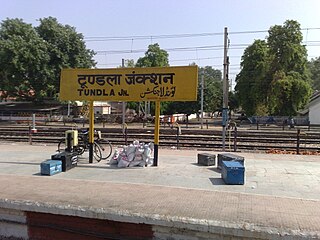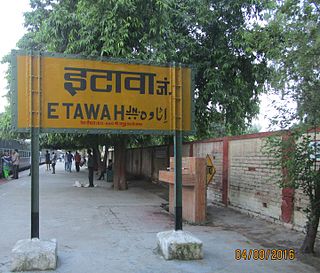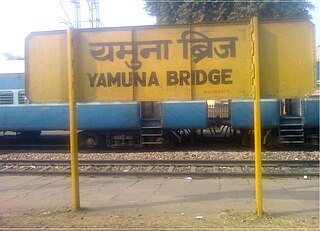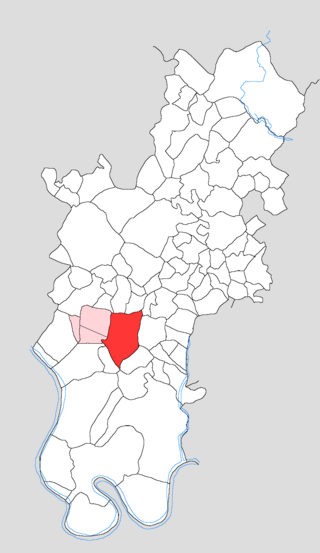
The Yamuna is the second-largest tributary river of the Ganges by discharge and the longest tributary in India. Originating from the Yamunotri Glacier at a height of about 4,500 m (14,800 ft) on the southwestern slopes of Bandarpunch peaks of the Lower Himalaya in Uttarakhand, it travels 1,376 kilometres (855 mi) and has a drainage system of 366,223 square kilometres (141,399 sq mi), 40.2% of the entire Ganges Basin. It merges with the Ganges at Triveni Sangam, Prayagraj, which is a site of the Kumbh Mela, a Hindu festival held every 12 years.

Agra is a city on the banks of the Yamuna river in the Indian state of Uttar Pradesh, about 230 kilometres (140 mi) south-east of the national capital Delhi and 330 km west of the state capital Lucknow. With a population of roughly 1.6 million, Agra is the fourth-most populous city in Uttar Pradesh and twenty-third most populous city in India.

Etawah, also known as Ishtikapuri, is a city on the banks of Yamuna River in the state of Western Uttar Pradesh in India. It is the administrative headquarters of Etawah District. Etawah's population of 256,838 makes it the 180th most populous city in India. The city lies 300 km (190 mi) southeast of the national capital New Delhi, 230 km (140 mi) northwest of the state capital Lucknow, 120 km east of Agra and 140 km west of Kanpur. The city was an important centre for the Indian Rebellion of 1857. It is also the sangam or confluence of the Yamuna and Chambal rivers. It is the 26th most populous city in Uttar Pradesh.

Etah district is one of the districts of Uttar Pradesh, India, since 1854. Etah City is the district headquarters. Etah district is a part of Aligarh Division.

Firozabad district is one of the western districts of the Indian state of Uttar Pradesh, which has Firozabad city as its district headquarters. The district is a part of the Agra division.
Shikohabad is a city and a municipal board in the Firozabad district of the Indian state of Uttar Pradesh.

Tundla is a town and a municipal board in Firozabad district in the Indian state of Uttar Pradesh. It is an important railway junction between the Delhi-Kanpur main line and the Agra branch line. Tundla is a railway town that sprang up when the railway was built in the late 1800s. It is served by Tundla Junction railway station. As of 2011, Tundla has a population of 50,423 people, in 8,744 households.

Tundla Junction is an important station in Uttar Pradesh. It is located on the Delhi–Howrah main line 25 km from Agra City. Tundla is a technical halt for changing drivers and guards for almost all of the trains on the New Delhi–Pandit Deen Dayal Upadhyaya Nagar / Lucknow sections. The station was built by the British and remains essentially unchanged. The railway station is a site in itself and takes one back to the pre-independence era.

The Kanpur–Delhi section is a railway line connecting Kanpur Central and Delhi. This section includes Agra Chord and Etah link. The main line is part of Howrah–Delhi main line and Howrah–Gaya–Delhi line. The Agra–Delhi chord is part of Delhi–Mumbai line and Delhi–Chennai line.

Etawah Junction railway station is one of the main railway stations on the Kanpur–Delhi section of Howrah–Delhi main line and Howrah-Gaya-Delhi line.It is 139 km (86 mi) away from Kanpur Central.Tundla is 92 km (57 mi) from here, from where lines to Agra bifurcates. It is located in Etawah district in the Indian state of Uttar Pradesh. It serves Etawah and the surrounding areas. Etawah stands near the confluence of the Yamuna and the Chambal.

Hathras Junction railway station is on the Kanpur–Delhi section of Howrah–Delhi main line and Howrah–Gaya–Delhi line. It is located in Hathras district in the Indian state of Uttar Pradesh. It serves Hathras and surrounding areas.

Firozabad railway station is on the Delhi-kanpur section of Delhi-Howarah Main line and Howrah–Gaya–Delhi line. It is located in Firozabad district in the Indian state of Uttar Pradesh. It serves Firozabad.

Shikohabad Junction railway station is on the Kanpur-Delhi section of Howrah–Delhi main line and Howrah–Gaya–Delhi line. It is located in Firozabad district in the Indian state of Uttar Pradesh. It serves Shikohabad.

Yamuna Bridge railway station is on the Tundla–Agra branch line. It is located in Agra district in the Indian state of Uttar Pradesh. It serves Etmaddoula and surrounding neighbourhoods in Agra.

Saifai is a large village and university town in the Etawah district of the Indian state of Uttar Pradesh. It is also a sub-division (Tehsil) and Block of the Etawah district. It is the birthplace of Mulayam Singh Yadav, the founding president of the Samajwadi Party, former Minister of Defence in India, and former Chief Minister of Uttar Pradesh.

Phaphund railway station is an "A" graded railway station in Auraiya district, Uttar Pradesh, India. Its code is PHD. It serves Auraiya district and Dibiyapur city. It is located on the Kanpur–Delhi section of Howrah–Delhi main line and Howrah–Gaya–Delhi line. It is one of the main serving railway stations on the Kanpur–Delhi section of the Prayagraj railway division. Built during British rule, the station is owned by Indian Railways and operated by North Central Railway and consists of five tracks and four platforms.

Chulhawali, also spelled Chulhaoli, is a village in Tundla block of Firozabad district, Uttar Pradesh. As of 2011, it has a population of 7,151, in 1,211 households. The population is mainly Hindu, with the most prominent community being Jats of the Solanki gotra. Other castes include Brahmans and Jatavs (ravidasiya).

National Highway 19 is a national highway in India. It was previously referred to as Delhi–Kolkata Road and is one of the busiest national highways in India. After renumbering of national highways, Delhi to Agra route is now national highway 44 and Agra to Kolkata route is numbered national highway 19. It constitutes a major portion of the historical Grand Trunk Road. It is also part of AH1 of Asian Highway Network, that traverses from Japan to Turkey.

Dhirpura is a large village in Tundla block and tehsil of Firozabad district, Uttar Pradesh. It is located in the southeastern corner of the tehsil, on the north bank of the Yamuna river. Besides the main site, there are also numerous outlying hamlets. As of 2011, Dhirpura has a population of 14,478, in 2,210 households.

Chandwar is a village in Firozabad block of Firozabad district, Uttar Pradesh, India. Although now a humble village, it was historically the main town in the region during the Middle Ages. As of 2011, it had a population of 12,004, in 2,101 households.




















